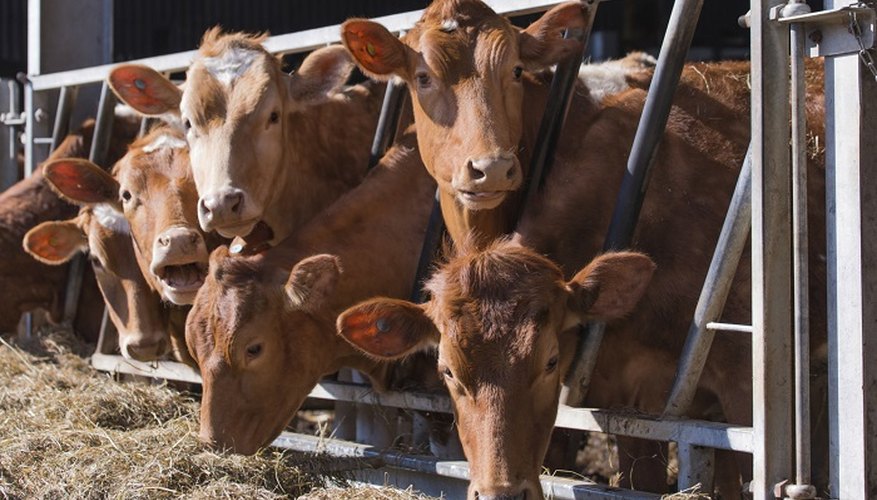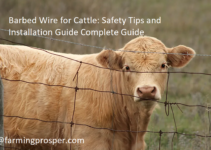Are you thinking of using an electric cattle prod on your farm? While it may be a useful tool for controlling cattle, you should also consider the potential risks and drawbacks.
In this guide, we’ll share the pros and cons of electric cattle prods so you can make an informed decision.
Cattle prods are widely used tools on farms and ranches for handling, moving and controlling cattle. They are designed to deliver a short, sharp shock to cattle, and are commonly used to startle, distract or herd animals. While there are a number of advantages to using a cattle prod, it’s important to understand the risks associated with them as well. This guide provides an overview of the advantages and disadvantages of employing a cattle prod on your farm and the potential implications for animal welfare.
Before discussing the pros and cons in detail, it is important to understand what makes up a typical cattle prod. Generally speaking, these devices consist of two main parts: an activating lever which is connected by a long cord or trigger handle to an insulated metal rod with electrodes at one end. When activated via the trigger handle, an electric current is transmitted along the metal rod toward the livestock’s hide or body. The size of the device can vary depending on its intended use but they typically range from 10-60 inches in length with electrode tips from ¼-1 inch in diameter. At their maximum capacity current output can reach up to 218 watts.
Explanation of what a cattle prod is
A cattle prod is an electric shocking device commonly used in the farming industry to control and move large animals, typically cattle. This type of device is powered by either one or more batteries or supplies a single electrical shock on contact which is delivered through two metal prongs at the end of the prod. In order to operate, the farmer must be holding the prod in his/her hand while touching the animal with it.
Cattle prods are seen as an effective method due to the quickness it takes for a small jolt of electric current to move a large animal such as a cow from one place to another. The current is considered mild enough not to irritate or harm any livestock but provides just enough discomfort that motivates them away from where they were standing or guide them in some way.
Since these are considered electric agricultural devices, many safety standards and regulations have been set and vendors who sell cattle prods must adhere to them in order for their products to reach their audience safely.

Importance of discussing the pros and cons of using a cattle prod
When considering whether to use a cattle prod on your farm, it is important to gain an understanding of the potential benefits and drawbacks of the device. Cattle prods are useful tools that can provide a quick and effective way of controlling or moving animals in a variety of farming and agricultural operations. However, there are pros and cons that need to be considered before deciding on their use.
The pros of using a cattle prod include its effectiveness. A prod’s short electric shock provides an immediate response from animals that is guaranteed to get their attention quickly and efficiently. Prods will help you control large groups of animals with very little effort, as well as giving you the advantage of being able to move them away from danger or into pens quickly if needed. The prods also put minimal stress on your livestock — unlike many other methods such as herding — making treatment easier for both you and your herd.
The cons should also be taken into consideration before deciding whether to incorporate prods into your operation. While one or two electric jolts may not be harmful for most livestock, overusing them can cause pain and stress for your animals, leading to unnecessary suffering which should definitely be avoided under all circumstances. Furthermore, their application often requires handling the animal directly which presents potential injury risks both for farmers as well as the animals they are trying to control.
Ultimately it is up to individual farmers to decide if cattle prods are suitable tools for them and their operation or not; this decision should be based on carefully weighing all available evidence surrounding the effectiveness of prods versus any potential dangers they could pose either physically or psychologically to their livestock.
Purpose of the guide
This guide is designed to provide farmers with the knowledge they need to make an informed decision about the use of a cattle prod on the farm. By providing an overview of what a cattle prod is, how it works, and the pros and cons associated with its usage, this guide will help farmers determine if investing in such equipment is right for their particular farm.
The main points discussed in this guide are as follows:
- Definition and history of cattle prods
- Types of cattle prods available
- Mechanics of how a cattle prod works
- Benefits of using a cattle prod
- Pros and cons of wielding a cattle prod
- Safety concerns associated with using a cattle prod
- Alternatives for providing livestock guidance
Pros of using a cattle prod
Using a cattle prod can have several advantages for individuals who work on farms. Oftentimes, farmers need to move animals from one location to another quickly, but if the animals become agitated or uncooperative, the process can be stressful and dangerous. A cattle prod gives the farmer a way to control an animal in a quick, safe manner when it is not behaving as desired. Some of the potential benefits of using a cattle prod on your farm include:
- Easier Way To Move Animals: Cattle prods make it far easier to move animals around on your farm. With relatively little effort, you can encourage an animal to move where you want it to go quickly and safely. Additionally, because a cattle prod is shock-free and designed with safety in mind, there is no risk of harming the animal.
- Increased Control: When working with livestock, it is always important that you maintain control over the situation at all times for your own safety as well as that of the animals. With a cattle prod in hand, you are better equipped to handle difficult situations such as when an animal refuses commands or becomes unruly and won’t cooperate with your orders.
- Improved Work Efficiency: Everyone wants things done quickly and efficiently on their farm! A cattle prod helps ensure that issues involving animals can be taken care of fast so you don’t waste time struggling with difficult livestock tasks. This efficient solution means that you will get more accomplished with more accuracy each day!
Helps move cattle quickly and efficiently
A cattle prod is an effective tool for quickly and efficiently moving cattle from one location to another. Electric prods generally feature brass contacts or a conductive mesh that delivers a brief electrical shock when triggered. The shock encourages the targeted livestock to move in the desired direction. While these tools may help you control your herd, there are some considerations you should take into account prior to using them on your farm.
Advantages
The primary advantage of using a cattle prod is that it can reduce the amount of labor involved in moving animals from one location to another. This tool helps with corralling and herding cattle rapidly and safely, which can save valuable time and effort compared to manual methods, such as waving hats or prompting with sticks. The use of electric prods can also lead to improved animal welfare as it decreases the need for physical contact while still delivering an effective behavior modification cue.
Disadvantages
However, there are some potential disadvantages associated with this kind of equipment. Prods may be too powerful for smaller breeds of cattle or young animals who do not yet have developed senses of direction or awareness when being moved. Additionally, these tools must be used cautiously: improper use on animals can cause serious injury or harm, resulting in legal consequences for careless farmers who abuse their stock indiscriminately for their own convenience. Finally, overestimating its effectiveness – expecting it to work even during extreme weather conditions or when several animals need to be moved simultaneously – may result in a frustrating experience as well as increased stress on animals that could lead to long-term psychological damage and affect their productivity levels overall.
Can be used as a safety tool for handlers and animals
Cattle prods are primarily used as a safety tool for handlers and the animals they are working with. In some cases, it is necessary to help start or move cows that may be timid or reluctant in order to avoid animal stress and potential injuries.
When used properly, a cattle prod can minimize physical contact between handler and animal while allowing the handler to control a large group of animals efficiently. This can make it easier to move animals through narrow passages and keep control of the herd.
Furthermore, cattle prods are effective deterrents against predators such as coyotes or mountain lions, providing a non-lethal solution for protecting animals from harm.

Increases productivity and saves time
Using a cattle prod encourages animals to move quickly and efficiently, minimizing the amount of time required for herding. This can save you a great deal of time and effort, as well as reducing stress levels for both you and your cattle.
The movement is natural, fast-paced and safe when the prod is used responsibly, meaning that animals will be shepherded successfully in a much shorter amount of time. With this saving in labor costs, it can be worthwhile investing in a cattle prod to make herding more efficient on your farm.
Cons of using a cattle prod
Using a cattle prod is not without its drawbacks. While it can be useful in some instances, there are common issues to consider when weighing the pros against the cons.
The most obvious con of using a cattle prod is that it causes pain and discomfort to the animal. This discomfort can be amplified if used improperly or excessively, which could lead to both physical injury and psychological distress. Additionally, since cows tend to possess herding instinct, shock collars and prods can inhibit their natural behavior and create a longer-term issue with respect to social behaviors within the herd. If not handled with care, an animal may remember that shock and associate it with human presence altogether. This can cause cattle to avoid their handlers even when they are trying to help them or provide them with food, meaning that it may become even more difficult for ranchers to address any remaining issue they have with their herd animals.
In the same vein another issue pertains directly to the use of electricity –that of shock strength; an over delivery of electricity can cause extreme harm or even death if used improperly on livestock species such as cows. As such particular caution should be taken in regards to any device that produces electric current . Electric fright prods need utmost quality control during production and assembly–which also comes at an increased cost in terms of upfront expenses when compared to manual labor . It is also important then for purchasers of these products—whether store owners or ranchers—to evaluate how these devices will be utilized on their farm before using them on live livestock .
Can cause injury or pain to the animal
The use of a cattle prod on an animal can have certain adverse effects.
First, a cattle prod can cause injury or pain to the animal, which in turn can lead to short-term and long-term fear and anxiety.
In addition, prods that are used too often or too aggressively could create stress in the animal, leading to further behavioral challenges such as aggression towards humans.
Always exercise caution when using a prod against an animal in order to ensure its safety and well-being.
May result in fear and stress for the animal
Using a cattle prod on an animal can potentially cause them a lot of stress and may even lead to traumatic fear or phobia. It is important to note that animals have the ability to remember experiences, both positive and negative, so a bad experience with a cattle prod could be remembered for years in the form of fear and agitation.
If used too harshly or too often, the stress caused by cattle prods can lead to changes in behavior, low reproductive rates and even poor health. For this reason, it is best to refrain from using such prods unless absolutely necessary.
Additionally, whenever deciding whether or not a cattle prod should be used for an animal on your farm, it’s essential that you weigh up the potential benefit versus risk factors involved.
Potential for misuse and abuse
Although cattle prods provide a controlled and humane way to move cattle, they can also be misused. For example, if an inexperienced person uses the prod incorrectly or for too long, it can cause permanent injury or even death.
Additionally, prods can be used to intimidate or bully livestock, which is not only cruel but goes against best practices in herd management. If a producer abuses the prod on any consistent basis, it may indicate that they lack experience or have unethical motivations in raising their livestock.
It is important to note that while cattle prods are humane when used correctly, any abuse of the prod should be rectified as soon as possible either through training and knowledge sharing or by removing the offending individuals from livestock handling duties altogether.

Conclusion
Overall, using a cattle prod on your farm can be an effective method of animal husbandry in some cases. However, when used improperly or without valid reason, it can do more harm than good. For this reason, it should only be considered as a last resort.
Cattle prods are most effective when used by experienced ranchers who are familiar with the nuances of proper animal handling and husbandry techniques. Regardless of whether you choose to use a prod in your operation or not, understanding how it works and its potential benefits and drawbacks is essential for successful ranching.
Ultimately, using a cattle prod as part of an overall animal husbandry strategy can help your herd stay healthy, productive and safe.
FAQ
What are the disadvantages of cattle farming?
Some potential disadvantages of cattle farming include high resource consumption, environmental impact, and ethical concerns related to animal welfare.
What are the effects of a cattle prod?
Cattle prods are designed to deliver an electric shock to cattle to encourage movement or behavior change. While the shocks are not typically harmful, they can cause pain, stress, and fear in the animals.
Why use a cattle prod?
Cattle prods are used in situations where it is necessary to move or handle large or stubborn cattle. They can be effective in encouraging movement and reducing stress on both the cattle and the handlers.
How bad would a cattle prod hurt?
A cattle prod can cause pain, stress, and fear in the animals it is used on. The level of discomfort experienced by the animal will depend on the voltage of the prod, the duration of the shock, and the sensitivity of the animal.
What are the negative effects of cattle industry?
The negative effects of the cattle industry include greenhouse gas emissions, water pollution, habitat destruction, and deforestation. Additionally, animal welfare concerns are often raised due to the large-scale confinement and management of cattle.
Do cattle prods shock you?
Cattle prods are designed to shock cattle, not humans. However, it is possible for a human to accidentally receive a shock from a prod, which can be painful and potentially dangerous.
What are 4 negative impacts of food cattle production?
The negative impacts of food cattle production include deforestation, water pollution, greenhouse gas emissions, and the potential spread of diseases.
What are 4 challenges of cattle farming?
Challenges of cattle farming may include managing herd health, providing adequate nutrition, ensuring animal welfare, and adapting to changes in market demand or weather patterns.
What is the biggest problem with cattle farming?
The biggest problem with cattle farming is likely its environmental impact. The industry is a significant contributor to greenhouse gas emissions, water pollution, and deforestation.
What are the disadvantages of animal product processing?
The disadvantages of animal product processing include environmental damage caused by waste and pollution, ethical concerns regarding animal welfare, health risks associated with consumption of processed animal products, and potential for foodborne illness if processing is not done properly.
See Also :
- Best incubator for duck eggs 2023
- Best barbed wire for cattle 2023
- Best milkhouse heater 2023
- Best cattle ear tags 2023
- Best rotary tiller for tractor 2023


